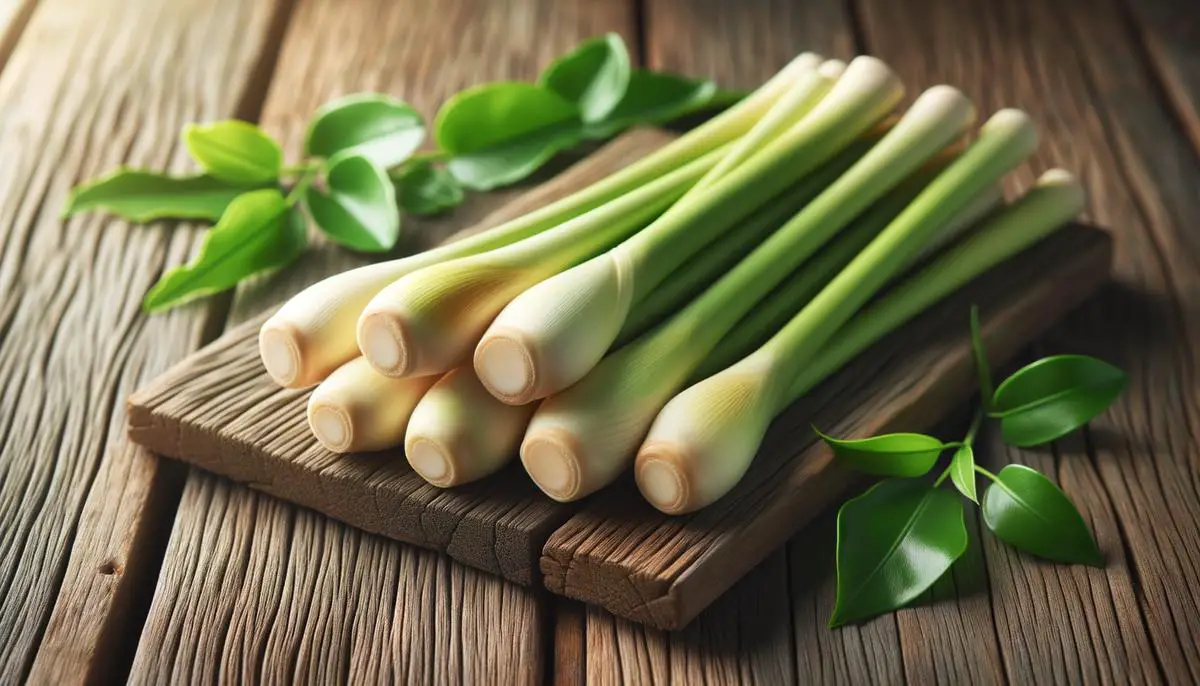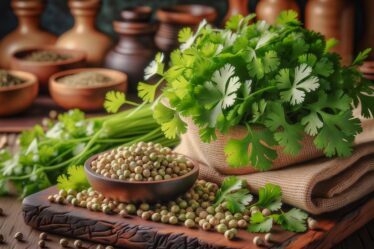
Lemongrass: A Versatile Herb
Lemongrass, that zesty herb originally hailing from the lush landscapes of maritime Southeast Asia, has stretched its aromatic influence far beyond the borders of places like Indonesia and Singapore. It's been a game-changer in kitchens across the globe, adding a splash of lemony relish that's out of this world! Especially when it comes to pepping up meats and turning soups into a heartwarming adventure.
Imagine preparing a toothsome Thai soup or a zesty Vietnamese salad and bringing in a touch of lemongrass—it's like adding a burst of sunshine on a cloudy day! The unique combination, a hint of ginger with loads of citrusy lemon overtones, dances across your taste buds. Western food enthusiasts have been quick on the uptake, now commonly integrating lemongrass into all sorts of evocative concoctions.
Whether blending into fancy cocktails or giving that extra kick to a marinade for barbequed meats, lemongrass pulls out an elegant flavor profile that turns a simple meal into something memorable. Lemongrass has been creeping into our beverages too. You sip on that lemongrass-infused mocktail and instantly find yourself whisked away to some tropical island paradise, no tickets needed!
If you haven't yet introduced your spice cabinet to lemongrass—or if it's been sitting there idly—you're missing out on some fantastic flavor elevations!
As lemongrass sees soaring acclaim from food lovers near and far, its transcultural journey has turned into an aromatic saga of flavor and reminiscence, touching lives, one divine dish after another. Newbies are signing up for more, as they discover the magic it spins, partnered aptly with both flair and taste. So next time you're out shopping for ingredients, reach for that fresh bunch of lemongrass—you'll thank me later!
Health Benefits and Nutritional Info
Lemongrass doesn't just lift the citrusy charm in our kitchens; it packs a powerful punch of health benefits alongside a nourishing profile. Rich in antioxidants, this herby hero goes head to head with free radicals, aiming to shield our cells from damage and help fend off numerous chronic diseases. The anti-inflammatory properties of lemongrass can soothe inflammation, making it a great ally for those dealing with conditions like arthritis.
Lemongrass is a splendid source of vitamins A and C, which are crucial for immune health and skin vitality. It also provides essential minerals such as potassium and magnesium, significant for heart health and enzymatic functions within the body.
With its calming properties, this herb helps maintain digestive health, which rounds off why it's more than just a flavor enhancer in the culinary world. Adding lemongrass to your diet means embracing not only its vibrant taste but also bolstering your wellness routine. Swirling a stalk into your next soup or brewing it into a tea could be the upgrade your body thanks you for! Integrating this aromatic herb into your food might turn simple recipes into nourishing meals that taste as good as they feel.
Preparation and Storage Tips
Selecting the perfect lemongrass at your market involves scouting for firm, fragrant stalks. The lower part of the stalk should be pale and slightly bulbous; this is what you use in cooking, so you want it to appear healthy and stout. The leaves might be long and may appear a bit drier; that's normal, they're mainly used for making teas or flavoring broths where they're not eaten.
When you're home, ready to propel your dish into a realm of vibrant zest with lemongrass, start by peeling away the outer layers which are tough and not very flavorful. What you want is the softer, more colored part inside. Then slice off the lower bulb before smashing the lemongrass with the flat side of a knife—or go the traditional route using a mortar and pestle—to release their flavorful oils, making them suitable for cooking or brewing into teas.
Storing lemongrass appropriately is crucial for retaining its aroma and freshness. In the refrigerator, wrap your lemongrass loosely in a plastic bag and stash it in the vegetable drawer; it should last a couple of weeks. If you have more lemongrass than you can use in that time, freezing offers an excellent solution. Freeze whole stalks, individually wrapped tightly in plastic wrap or place them in an airtight container. When you need them, there's no need to thaw; you can chop or crush them while still frozen and toss directly into your cooking pot! This method keeps the lemongrass vibrant and ready to infuse your meals with that characteristic citrus flair, month after month.
Lemongrass Infused Dishes
The allure of lemongrass extends into an array of dishes, suiting palates craving traditional tastes or those aspiring for a twist on the conventional. In traditional Southeast Asian cuisine, nothing partners better with lemongrass than a vibrant Thai curry. Here, lemongrass is not just an optional add-in; it's the backbone, bringing depth and brightness that balances the rich coconut milk and the heat from the chilies perfectly.
For a fulfilling lemongrass-powered meal, consider mixing this aromatic herb into a Vietnamese Lemongrass Beef Stew. The stew, enriched with flavors soaked up from marinated beef, showcases lemongrass as a prime microwave that tenderizes and infuses the meat with a burst of citrus tang, setting off the spices beautifully.
Lemongrass demonstrates its versatility by sneaking into desserts. Picture a Lemongrass-Infused Creme Brulee—the zest of lemongrass cut through the richness of the custard, offering a refreshing aftertaste that cleanses the palate rather than weighing it down. Or, envision a citrusy sorbet where lemongrass couples with lemon or lime for a doubly refreshing scoop.
For those shaking up their drink selections, lemongrass serves up wonderfully in a homemade lemonade or as a subtle twist in a gin-based cocktail, adding layers of flavor that unfold with each sip. Its light, zesty nature complements the sharpness of the gin, yielding a concoction that's both invigorating and soothing.
Through each dish and drink, from soupy curries to frozen desserts, lemongrass introduces a world of flavor saturated with essences that resonate across continents, crafting a narrative of taste that champions both tradition and innovation. Its subtle yet impactful presence underscores why lemongrass is cherished far and wide, leaving a trace of citrus that enlivens the culinary landscape wherever it's used. Whether as a standout element or a background note, it enriches and transforms ordinary ingredients into extraordinary experiences.
Lemongrass Tea: Preparation and Benefits
Preparing lemongrass tea is surprisingly simple and delivers a delightful, soothing beverage rich in calming flavors. Here's how you make it:
- Boil 1 cup of water.
- Take 1 to 3 teaspoons of fresh or dried lemongrass. If you're using fresh lemongrass, roughly chop it to release more flavor.
- Add the lemongrass to the boiling water and let it steep for about 5 minutes. The longer it steeps, the stronger the flavor.
- Strain the lemongrass pieces from the water and serve the tea hot. If a chilled beverage is preferred, simply allow the tea to cool and add ice cubes.
The beauty of lemongrass tea isn't merely in its ease of preparation but also in its wealth of benefits. This aromatic beverage is well-known for its potential digestive benefits; many find it alleviates symptoms like bloating and indigestion. The relaxing properties of lemongrass can also contribute to stress relief, making this tea an excellent choice for unwinding after a long day. The clean, citrusy flavor not only refreshes the palate but makes it a pleasant drink for almost any time of day.
With each sip, you welcome a kind of serenity that seems to wash over, making lemongrass tea not just a beverage, but a simple way to care for your well-being daily. Whether starting the day with a clear mind or concluding an evening with a gentle wind-down, lemongrass tea presents a flavorful companion to these moments.
Recipe: Lemongrass Ginger Chicken
Ingredients:
- 4 chicken breasts
- 2 lemongrass stalks, finely minced
- 2 inches of ginger root, peeled and grated
- 3 garlic cloves, minced
- 2 tablespoons soy sauce
- 1 tablespoon fish sauce
- 1 tablespoon honey
- Juice of 1 lime
- 2 tablespoons vegetable oil
- Salt and pepper, to taste
- Fresh cilantro, chopped (for garnish)
- Sliced lime wedges (for serving)
Instructions:
- Whisk together the minced lemongrass, grated ginger, minced garlic, soy sauce, fish sauce, honey, and lime juice to create the marinade.
- Season the chicken breasts with salt and pepper. Place them in a large resealable plastic bag or a shallow dish.
- Pour the marinade over the chicken, making sure each piece is well-coated. Seal the bag or cover the dish and refrigerate for at least 30 minutes, ideally for a few hours to enhance flavors.
- Heat the vegetable oil in a large skillet over medium-high heat. Once hot, remove the chicken from the marinade (discard leftover marinade) and place it in the skillet.
- Cook the chicken for about 6 to 7 minutes on each side, or until golden brown and cooked through. The internal temperature should reach 165°F.
- Transfer the cooked chicken to a serving plate. Garnish with chopped cilantro and provide lime wedges on the side.
- Serve this Lemongrass Ginger Chicken with steamed rice or stir-fried vegetables for a well-rounded meal that's both vibrant and satisfying.
Nutritional information per serving:
- kcal: 250
- carbohydrates: 10g
- protein: 30g
- fat: 10g
- sodium: 800mg
Recipe: Lemongrass Coconut Curry
Ingredients:
- 2 tablespoons coconut oil
- 1 onion, finely chopped
- 3 garlic cloves, minced
- 2 tablespoons freshly grated ginger
- 2 lemongrass stalks, tough outer layers removed, finely minced
- 1 red bell pepper, thinly sliced
- 2 carrots, thinly sliced
- 1 zucchini, sliced into half-moons
- 1 tablespoon curry powder
- 1 teaspoon ground turmeric
- 1 can (14 ounces) coconut milk
- 1 cup vegetable broth
- 2 teaspoons sugar
- Salt to taste
- Fresh basil leaves, for garnish
- Sliced red chili, for garnish
Instructions:
- Heat the coconut oil in a large saucepan or skillet over medium heat. Add the chopped onion, minced garlic, and grated ginger. Cook, stirring frequently, for about 5 minutes until the onions become translucent.
- Stir in the minced lemongrass and cook for another minute to release its citrusy fragrance.
- Add the sliced red bell pepper, carrots, and zucchini to the pan. Cook, occasionally stirring, for about 5 minutes until the vegetables start to soften.
- Sprinkle the curry powder and ground turmeric over the vegetables. Stir well to coat each piece with the spices and cook for another minute to enhance their flavors.
- Pour in the coconut milk and vegetable broth. Stir in the sugar and season with salt. Bring the mixture to a low boil, then reduce the heat and let it simmer gently for about 20 minutes, or until the vegetables are tender and the flavors have melded together.
- Taste and adjust the seasoning as needed. Remove from heat.
- To serve, ladle the curry into bowls. Garnish each serving with fresh basil leaves and slices of red chili for a touch of heat.
Exemplary on its own, this curry reaches new heights when served alongside jasmine rice or warm naan bread to soak up all the delicious sauce. Whether it's a chilly evening or a moment of culinary exploration, this Lemongrass Coconut Curry brings comfort and excitement to your table.
Nutritional information per serving:
- kcal: 300
- carbohydrates: 20g
- protein: 5g
- fat: 25g
- sodium: 500mg


